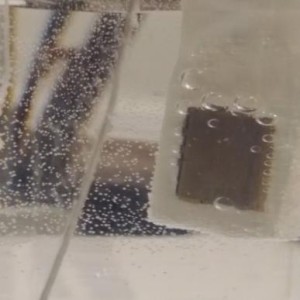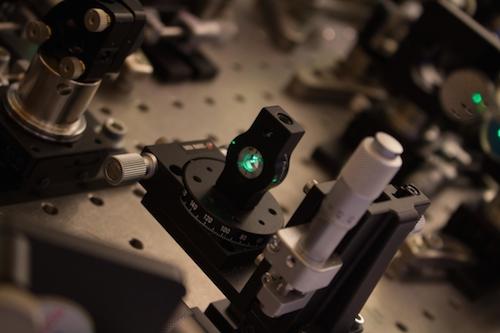 ECS is hosting a series of webinars presented by distinguished speakers this June. Join us! Speakers include Harry Atwater from the California Institute of Technology, Arumugam Manthiram from the University of Texas at Austin, and Paul Kenis from the University of Illinois at Urbana-Champaign. Topics include batteries, energy, carbon, and more. Considering attending? Learn more about what you can expect to hear about from our presenters! (more…)
ECS is hosting a series of webinars presented by distinguished speakers this June. Join us! Speakers include Harry Atwater from the California Institute of Technology, Arumugam Manthiram from the University of Texas at Austin, and Paul Kenis from the University of Illinois at Urbana-Champaign. Topics include batteries, energy, carbon, and more. Considering attending? Learn more about what you can expect to hear about from our presenters! (more…)
Device Mimics Photosynthesis to Make Chemical for Plastic
Posted on December 6, 2017 by Amanda StallerResearchers have developed a prototype device that mimics natural photosynthesis to produce ethylene gas using only sunlight, water, and carbon dioxide.
The novel method, which produces ethylene at room temperature and pressure using benign chemicals, could be scaled up to provide a more eco-friendly and sustainable alternative to the current method of ethylene production.
Ethylene, which is the building block of polyethylene, is an important chemical feedstock produced in large quantities for manufacturing plastics, rubber, and fibers. More than 170 million tons of ethylene were produced worldwide in 2015 alone, and the global demand is expected to exceed 220 million tons by 2020.
Ancient Bacteria Shed Light on Turning Water to Energy
Posted on November 21, 2017 by Amanda Staller Researchers have traced the paths of three water channels in an ancient photosynthetic organism—a strain of cyanobacteria—to provide the first comprehensive, experimental study of how that organism uses and regulates water to create energy.
Researchers have traced the paths of three water channels in an ancient photosynthetic organism—a strain of cyanobacteria—to provide the first comprehensive, experimental study of how that organism uses and regulates water to create energy.
The finding advances photosynthesis research but also presents an advance in green fuels research.
Photosynthesis is the chemical conversion of sunlight into chemical energy via an electron transport chain essential to nearly all life on our planet. All plants operate by photosynthesis, as do algae and certain varieties of bacteria.
‘Damage trails’
To convert sunlight into a usable form of energy, photosynthetic organisms require water at the “active site” of the Photosystem II protein complex. But the channels through which water arrives at the active site are difficult to measure experimentally. Reactive oxygen species are produced at the active site and travel away from it, in the opposite direction as water, leaving a “damage trail” in their wake.
“We identified the damaged sites in Photosystem II using high-resolution mass spectrometry and found that they reveal several pathways centered on the active site and leading away from it all the way to the surface of the complex,” says lead study author Daniel A. Weisz, a postdoctoral researcher in biology at Washington University in St. Louis.
Findings in Microbial Photosynthesis for Waste Water Treatment, Energy
Posted on January 9, 2017 by Amanda Staller A new study led by ECS member Haluk Beyenal reveals a novel type of cooperative photosynthesis with potential applications in waste treatment and bioenergy production.
A new study led by ECS member Haluk Beyenal reveals a novel type of cooperative photosynthesis with potential applications in waste treatment and bioenergy production.
The research details a unique metabolic process observed for the first time in a pair of bacteria, which could be used to engineer microbial communities. Beyenal and his team honed in on a bacterium known as Prosthecochloris aestaurii, which is able to photosynthesize by using sunlight and elemental sulfur or hydrogen sulfide.
This from Washington State University:
The researchers noticed that P. aestuarii tended to gather around a carbon electrode, an electricity conductor that they were operating in Hot Lake. The researchers isolated and grew P. aestuarii and determined that, similar to the way half of a battery works, the bacterium is able to grab electrons from a solid electrode and use them for photosynthesis. The pink-colored Geobacter sulfurreducens meanwhile, is known for its ability to convert waste organic matter to electricity in microbial fuel cells. The bacterium is also used in environmental cleanup.
Physics Meets Photosynthesis in New Solar Cell Development
Posted on November 30, 2016 by Amanda Staller Researchers from the University of California, Riverside recently combined photosynthesis and physics to make a key discovery that could lead to highly efficient solar cells.
Researchers from the University of California, Riverside recently combined photosynthesis and physics to make a key discovery that could lead to highly efficient solar cells.
Nathan Gabor, a physicist, began exploring photosynthesis when he asked himself a fundamental question in 2010: Why are plants green? This question probed him to combine his physics training with biology.
Over the past six years, Gabor has been rethinking energy conversion in light of these questions. His goal was to make solar cells that more efficiently absorb intermittent energy from the sun and increase past the current 20 percent efficiency. In this, he was inspired by the plants that had evolved over time to do exactly what he hoped solar cells would be able to do.
This from University of California, Riverside:
[The scientists] addressed the problem by designing a new type of quantum heat engine photocell, which helps manipulate the flow of energy in solar cells. The design incorporates a heat engine photocell that absorbs photons from the sun and converts the photon energy into electricity.Surprisingly, the researchers found that the quantum heat engine photocell could regulate solar power conversion without requiring active feedback or adaptive control mechanisms. In conventional photovoltaic technology, which is used on rooftops and solar farms today, fluctuations in solar power must be suppressed by voltage converters and feedback controllers, which dramatically reduce the overall efficiency.
At the core of the research, Gabor and his team are looking to connect quantum mechanical structure to the greenest plants.
A new breakthrough in the measurement of solar energy flow has emerged from Lund University.
For the first time ever, researchers have successfully demonstrated the accurate measurement of solar energy in and between different parts of a photosynthetic organism. Gaining this basic understanding could potentially open doors to the development of solar energy technologies with much higher efficiency levels.
Researchers have known about the photochemical reactions inside organisms for over 80 years, but have not understood exactly how solar energy is transported to the organism.
“Not even the best solar cells that we as humans are capable of producing can be compared to what nature performs in the first stages of energy conversion,” says Donatas Zigmantas, co-author of the study. “That is why new knowledge about photosynthesis will become useful for the development of future solar technologies.”

Water splitting into hydrogen on a metal wire and oxygen on the catalyst.
Source: Yale Entrepreneurial Institute
New research out of Yale University, led by Ph.D. student Staff Sheehan, recently unveiled a new catalyst to aid in the generation of renewable fuels.
Sheehan’s main area of research has been water splitting. In his recently published paper, he takes the theories and processes involved in water splitting and uses a specific iridium species as a water oxidation catalyst. This has led to new breakthroughs in artificial photosynthesis to develop renewable fuels.
“Artificial photosynthesis has been widely researched,” Sheehan says, “but water oxidation is the bottleneck—it’s usually the most difficult reaction to perform in generating fuel from sunlight.”



